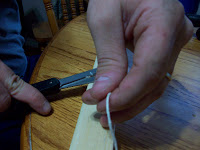Welcome to "the back 40" (as we call it)...I wish it were the back 40 acres, but its just the back 40 feet! Bryan built a cute picket fence and walkway in front of the garden to help section off the garden and bees from the rest of the yard.

We have planted 1 bed of beans that is doing fabulous and are getting ready to plant several more beds of beans as a fall crop. I love the various beans we have coming up. We planted a variety of colors so when the kids go exploring for beans they get to find yellow, purple and striped beans instead of just regular green beans...although they are tremendously fun to find as well!
Once the busy time of goat milking is done in the morning our backyard quickly becomes a very peaceful place to relax! The bee hives are tucked into the corner of the garden bringing thousands of pollinators quickly into our garden as well as a growth of fresh honey :) You can sit back and hear the peaceful hummmm of the workers comes from their hives. Then glance to the other side of the yard and see Peaches and Poppy relaxing after their morning milking. They love spending the cool breezy morning relaxing beside their bin of alfalfa while the chickens peck around the yard finding little "protein treats" (bugs)! Its quite a peaceful time of day! I fully enjoy the relaxation of watching my "backyard work for me". The garden is growing, the bees are buzzing around pollinating and storing up honey, the goats are "replenishing their milk supply", the chickens are laying eggs and being a fabulous bug pest control, and the chickens and goats are turning the compost pile as well as "producing compost" to enrich the soil!

It has been a tremendous amount of work to get our backyard to this level of productivity...but we have no intention of stopping here!! We are continually trying to find new ideas to put our little plot of land to work!
The front 3 beds are now empty after harvesting the leafy greens (arugula, lettuce, and spinach) and peas. We prepped those beds to plant more bush beans and here soon we will plant our fall crop of beans in those beds.
Then we have 1 row of tomatoes, 1 bed of beans, and 2 beds of tomatoes.
Last year we planted a very wide variety of vegetables, all for the purpose of finding out what we like to grow and like to eat. Then after realizing there are some things we are terrible at growing we decided to limit our variety and use the "barter system". We can grow beans and tomatoes well and it is easy to trade those veggies with people who grow other vegetables well. Then of course we had to plant a few herbs for fresh garden herbs. We also have 1 row of quite a few different varieties of peppers and I am anxious to experiment with new recipes!
Taste the Rainbow!! Our tomatoes are taking off!! We planted a variety of colors and sizes and have already harvested a dozen pounds of tomatoes...that doesn't even count what Addie and Henry have eaten while standing out in the garden "harvesting".
We have 2 beds of tomatoes...its our "wall of tomatoes". I can not wait for these fresh balls of delightful flavor to flow out of the garden!! I have alot of canning I want to do as well as sun drying! We sundried several dozen pounds of tomatoes last year (which only ends up being a few pounds of dried tomatoes) and they were extremely fun to savor during the winter months! Sundried tomatoes are fabulous to toss into a winter pasta or salad...I plan to make much more this year!!
I used t-posts and cotton string to make my wall of tomatoes and so far it has done quite well. Now that the tomatoes are growing and branching out I can see that the weight of the tomatoes might be a little heavy for the thin cotton string I selected. I tied up some extra rounds of string to make sure the wall wont collapse under the weight and pressure from the plants. Last year I used some vinyl twine that held up really well but I Wanted to go with a string that would be compostable and I sure hope the walls don't collapse with the stretching of this cotton string! This method easily contains the tomatoes and helps these 8 foot tall plants have somewhere to go as they grow taller and taller. Last year we had tomato plants well over 10 foot tall by the end of the season.
I hope everyone's gardening adventures are going well!! I would love to hear about your garden, animals and harvest!


























